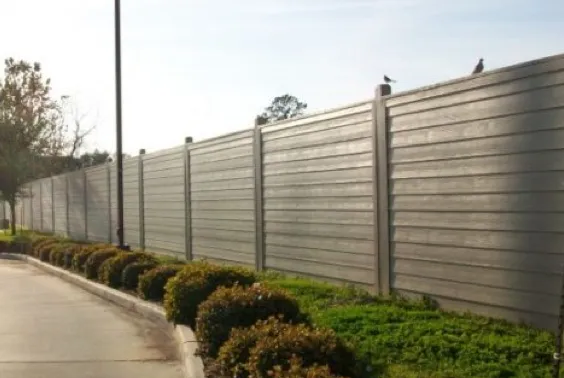Top Privacy Fence Materials for a Peaceful Backyard Retreat
Many of us dream of turning our backyard into a private sanctuary. Today, there are many innovative materials and designs for privacy fences. You can choose from natural wood, maintenance-free vinyl, or eco-friendly living screens. The right material is key to creating your perfect outdoor space. Let’s look at the top options for privacy fence materials.

Key Points
- Traditional cedar fencing is great for privacy. It naturally resists decay and insects and looks classic.
- Vinyl fencing is durable and needs little upkeep. It keeps its color and shape well against weather.
- Composite privacy panels are weather-resistant. They’re made from wood fibers and polymers, so they never need painting.
- Impact-modified PVC fencing fights pests, moisture, and UV damage. It also keeps its color well.
- Pressure-treated pine is an affordable choice. It’s protected against rot and termites with proper care.
Traditional Wood Privacy Fence
Wood privacy fencing is popular for its timeless look. Cedar and pressure-treated pine are top picks for durability.
Cedar fights off decay and insects naturally. Pressure-treated lumber adds extra protection against rot and termites. Choose kiln-dried boards to avoid warping and splitting. Heights from 6 to 8 feet work well for privacy without looking out of place.
For eco-friendly choices, look for FSC-certified wood. Apply water-resistant sealants every 2-3 years and use metal post anchors. A well-maintained wood fence can last 15-20 years. Western red cedar is especially good in humid climates, shrinking little over time.
Vinyl Privacy Fence Systems
Vinyl fence systems are gaining popularity. They’re durable against UV rays, moisture, and temperature changes.
Today’s vinyl fencing stays stable and colorful for decades. It only needs occasional cleaning with water to stay looking new.
The market now has more fade-resistant colors and textures. These mimic natural materials but perform better in weather.
The impact-modified PVC in vinyl fencing makes it resistant to pests and environmental damage.
Low Maintenance Color Options
Modern vinyl fence systems come in low-maintenance colors that won’t fade or peel. Try classic white and tan shades for timeless appeal. These UV-resistant colors stay vibrant for the fence’s life.
For modern homes, gray and slate options create sleek boundaries. Earth-toned shades like adobe and sandstone fit well with natural settings. Pick a color that matches your home and surroundings. Each shade we offer stays bright for decades, reducing environmental impact.
Durability Against Weather Elements
High-performance vinyl fence systems are very strong against different weather conditions. They handle UV exposure and temperature changes well. Vinyl doesn’t crack, peel, or fade, even in harsh sunlight or cold.
Vinyl’s flexibility lets it expand and contract without losing strength. This makes it a great choice for outdoor use.
More people are choosing vinyl for its weather-resistant properties. It doesn’t need sealing or staining like wood does. Its surface keeps moisture out, stopping rot, rust, and bugs.
When we pick vinyl for our privacy fence, we get a durable and good-looking option. It stands up to rain, snow, and wind.
Composite Privacy Panels
Composite privacy panels are great for those who want durable fencing that looks like wood. They mix recycled wood fibers with polymers that last long.
These panels have wood grain textures and earthy colors. They’re strong and look good, even in extreme weather.
The sound blocking properties make them perfect for a quiet outdoor space.
Low Maintenance Requirements
Composite privacy panels are easy to care for. They don’t need staining or sealing like wood does. They stay looking good with minimal upkeep.
These panels resist rot, warping, and bugs. A simple clean with soap and water keeps them looking new. No need to repaint or refinish.
The UV-resistant properties in these materials mean no need to repaint. This sustainable choice is better for the environment and saves money on upkeep of your privacy fence.
Weather-Resistant Properties
Composite privacy panels are great for outdoor use. They stay strong in all kinds of weather. They don’t warp, crack, or fade like other materials.
| Property | Benefit |
|---|---|
| UV Protection | Won’t fade or discolor over time |
| Moisture Resistance | Prevents rot and mold growth |
| Temperature Stability | Maintains shape in heat and cold |
The materials in these panels block UV rays and keep moisture out. They resist bugs and don’t need seasonal treatments. Choosing composite panels means a durable, beautiful fence for years.
Modern Design Options
Modern composite privacy panels are not just tough. They also offer a wide range of design possibilities that fit today’s architectural trends. You can find innovative textures that look like real wood, sleek designs, and mixed-material combinations that wow. They come in colors like warm earth tones, modern grays, and rich espresso.
We can add cool touches like lattice toppers, decorative post caps, and LED lighting to our outdoor areas. Many panels let us choose different heights, patterns, and shapes. This way, we can make our fences truly unique and match our home’s style.
Aluminum and Steel Privacy Fence Options
Metal privacy fencing is very durable, thanks to aluminum and steel. Each material has its own benefits for homes and businesses. Powder-coated aluminum is great for its weather resistance and modern look. Steel is strong and perfect for areas that need extra security.
Aluminum fencing is rust-free, needs little care, and is light. This makes it great for areas with slopes.
Steel fencing is thick and can hold up taller panels. It’s strong for tough places.
Both materials are good for the environment because they can be recycled and last a long time. This means they don’t need to be replaced often.
When finished right, these metal fences fit well with contemporary architecture. They stay looking good for many years.
Coastal areas especially like aluminum fencing. It doesn’t rust or corrode in salty air.
Natural Bamboo Screens
Bamboo screens are a sustainable privacy solution. They need little care and resist weather and bugs well. Bamboo’s distinctive aesthetic adds a modern touch to any landscape.
Today, bamboo screens can be installed in many ways. This includes metal supports and cable systems. These methods keep the material’s beauty while ensuring it’s strong.
If you want a stone look, SimTek’s EcoStone panels are a good choice. They’re an alternative to bamboo.
Maintenance and Long-Term Durability
Bamboo screens are sustainable but need care to last. We’ll show you how to keep them looking good and strong. This includes proven care techniques that keep bamboo beautiful and eco-friendly.
Use a UV-resistant sealer every 2-3 years. This keeps your screens looking rich and prevents damage.
Clean your bamboo screens every 6 months. Use a soft brush and mild soap to remove mold or mildew.
Adding an overhang or cap can protect your bamboo from rain. This simple step can make your screens last up to 10 years longer.
Regular care keeps your bamboo screen privacy fence looking great. It also supports sustainable landscaping in our outdoor spaces.
Natural Look and Appeal
Bamboo screens have three main benefits for outdoor spaces. They offer rich honey-toned coloring, organic textural patterns, and a timeless Asian-inspired design. These features enhance both modern and traditional gardens.
The beauty of natural bamboo comes from its sustainable origins. Each pole has a unique grain pattern and color. This makes bamboo screens a living, eco-friendly addition to any outdoor space.
The material’s natural weathering process adds to its charm. Over time, it develops a silvery patina. This aging process enhances the screen’s beauty while keeping it strong.
Installation and Support Options
Bamboo’s beauty is matched by its need for proper installation. We use concrete footings or a track system to ensure stability. This protects the screen from wind and weather.
Let’s look at the key support options:
- Ground sleeve installation – We embed galvanized steel sleeves into concrete footings. This creates a strong base and allows for easy bamboo pole replacement.
- Track mounting system – We attach horizontal aluminum tracks to structures or posts. This makes installing panels quick and easy.
- Tension cable support – We use stainless steel cables between end posts for extra stability. This is great for taller screens.
These methods keep our bamboo privacy screens stable. They also maintain their sustainable appeal and natural aesthetic.
Stone and Masonry Walls
Stone and masonry walls are top choices for a privacy fence. They are durable and add a touch of sophistication. We can use natural stone, brick, or concrete blocks for different looks.
When designing these walls, we can add planters, lighting, or decorative caps. Modern techniques help them regulate temperature and reduce noise. Although they cost more upfront, they last long and increase property value. Like Hardie Plank fences, they withstand harsh weather while staying beautiful.
Living Green Fence Alternatives
Living green fences are a natural choice for privacy. They enhance outdoor spaces, support wildlife, and cut down on carbon emissions.
Fast-growing evergreen trees like Thuja Green Giant or Leyland Cypress create privacy in 3-5 years. They can grow up to 40-60 feet tall with care.
Bamboo is also a great choice for coverage and sustainability. Clumping species grow in a controlled way, avoiding neighbor’s spaces.
Mixed hedgerows add biodiversity and interest all year. They provide privacy and varied textures.
When planning your living fence, we consider your climate zone, soil, and maintenance needs. This ensures success over time.
While Western Red Cedar fencing is durable, living fences offer a sustainable privacy solution.
Mixed Material Privacy Solutions
Creative designs often mix different fence materials for looks and privacy. Homeowners mix metal panels with wood slats or stone with bamboo. This way, they use each material’s best points without its downsides.
Some popular mixes are weathering steel with cedar, concrete posts with recycled panels, and aluminum with hardwood. Mixing materials vertically or horizontally adds depth and interest. It also keeps your space secure. By using various textures and elements, fences can match both new and old homes while keeping things private.
Western Red Cedar is great for mixed fences because of its natural oil. It makes the fence last longer when paired with other materials.
Chain Link With Privacy Slats
Chain link with privacy slats is a smart and affordable choice. Modern vinyl and aluminum slats turn basic chain link into a solid privacy wall. They fit well with the mesh, making the fence look good and lasting long.
Privacy slats have big pluses:
- They resist UV damage, so they don’t fade or break down in bad weather.
- They come in many colors to match your home and garden.
- Replacing slats is easy, without harming the whole fence.
Choose wind-rated slats for areas with strong winds. They work well, giving 75-95% privacy while still letting air through. Regular checks keep your fence from rusting and stay safe.
PVC and Plastic Materials
PVC and vinyl are today’s top picks for privacy fences. They’re durable, need little care, and are good for the planet. PVC fences look modern and install easily.
| Feature | PVC Benefits | Environmental Impact |
|---|---|---|
| Lifespan | 20-30 years | Recyclable material |
| Maintenance | No painting | Low chemical usage |
| Weather resistance | UV protected | No toxic treatments |
| Color options | Throughout material | No paint waste |
| Installation | Modular design | Less waste |
PVC doesn’t rot, rust, or need staining like old fences. You can pick from many styles, from simple to fancy. It’s also good for the earth because it lasts a long time and can be recycled. The pre-fab panels make setting it up simple and secure.
Frequently Asked Questions
How Long Do Privacy Fences Typically Last Before Needing Replacement?
Good privacy fences can last 15-30 years, based on what they’re made of. Wood fences usually last 15 years, but vinyl and composite can go over 30 with the right care.
What Permits and Regulations Should I Check Before Installing a Fence?
We’ll check local laws, HOA rules, property surveys, and building permits. Remember to look at utility clearances and height limits for a fence that follows the rules.
Can I Install Privacy Fencing on Uneven or Sloped Terrain?
Yes, we can install privacy fencing on slopes. We use stepped panels or raked sections. This way, the fence follows the natural grade of your terrain, ensuring it looks good and stands strong.
How Much Maintenance Is Required Annually for Different Privacy Fence Types?
Wood fences need sealant every year. Vinyl fences should be cleaned twice a year. Metal fences need rust checks, and composite fences just need occasional washing to keep them looking good.
What Is the Average Cost per Linear Foot for Professional Fence Installation?
Wood fences cost $25-35 per foot. Vinyl fences are $35-45 per foot. Aluminum fences are $50-65 per foot. Premium materials like composite cost $45-60 per foot. This includes labor and materials.
Takeaway
We’ve looked at many privacy fence solutions. They balance looks, function, and being good for the planet. From cedar to composites, each has its own benefits for private outdoor areas.
Choosing weather-resistant, eco-conscious materials and smart designs, we create enduring privacy barriers. These enhance our backyards, reduce environmental harm, and lower upkeep needs.








